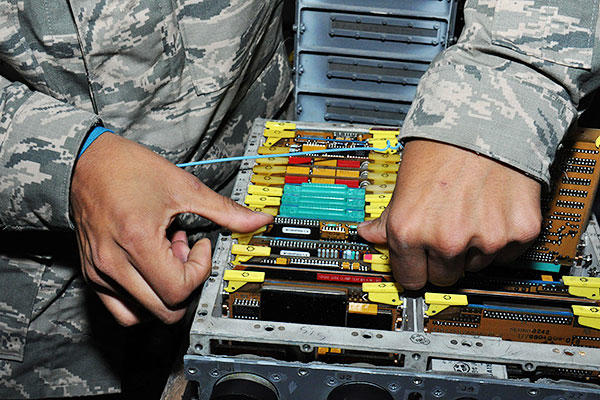AL UDEID AIR BASE, Qatar — Avionics specialists with the 379th Expeditionary Maintenance Squadron at Al Udeid Air Base, Qatar, manage an $83 million electronic warfare pod fleet and provide critical support to ensure aircraft stay mission ready.
The squadron's avionics flight manages the only Avionics Consolidated Repair Facility in the U.S. Central Command area of responsibility and services equipment on five different airframes, including the F-15 Eagle and B-1B Lancer.
In the past six months, the flight has performed 56 maintenance inspections and produced more than 1,000 line replaceable units. LRUs can be removed from an aircraft to be quickly fixed or replaced, such as a joystick from an F-15 or an antenna from a B-1B.
Staff Sgt. Charles Filholm, the 379th EMXS B-1B Lancer offensive avionics back shop team leader, said the avionics flight has an incredible impact on the mission.
"When our aircraft need something fixed so they can fly, we get it done," said Filholm, of Perry, Georgia. "It's a group effort; everyone in this shop is mission and team oriented. Every one of us wants to see those planes flying day after day."
The avionics flight, which has more than 30 Airmen, consists of two sections -- the avionics intermediate section and electronic countermeasures section. The AIS team focuses on providing intermediate-level maintenance support for F-15, F-16 Fighting Falcon, B-1B, A-10 Thunderbolt II and C-17 Globemaster III avionics systems. The ECM team provides maintenance support for the ALQ-184 and ALQ-131 electronic warfare pods.
Senior Airman Alex Mohr, a 379th EMXS EW team member from Dayton, Ohio, is one of more than a dozen Airmen who work in the electronic countermeasures section.
"We maintain our EW pods and perform periodic maintenance inspections on every one, three times a year," Mohr said.
An EW pod uses radio frequency radiation to jam enemy anti-aircraft weaponry. A pod receives a targeting signal from an enemy system, determines how to best counter that signal and then transmits its own signal to confuse or block the enemy targeting signal.
"Ensuring each pod is performing like it's supposed to is important work," Mohr said. "We ensure the pod transmits the proper radio frequency techniques to counter whatever enemy equipment may be out there."
"For example," Mohr said, "surface-to-air missile sites may try to hit our planes, so the pod attempts to jam the signals sent from those SAM sites."
The avionics intermediate section repairs a variety of aircraft equipment, including radar and flight control systems.
"We do a lot of work in this facility," Filholm said. "We've repaired antennas, power supplies, countermeasures boxes, and much more."
The AIS team maintains 11 test stations capable of replicating signals from five airframes to ensure flight systems are operating at the proper frequencies. The section receives approximately 54 LRUs per week.
With every repair, the avionics team saves the Air Force thousands of dollars. Over the past six months, the flight has saved $25 million by avoiding shipping and repair costs associated with shipping equipment back to the United States.
"Having us here enables us to repair equipment needed for all of our airframes in the AOR and get that equipment out swiftly and efficiently," Filholm said.
Maj. Joshua Depaul, the 379th EMXS commander, said to have a consolidated repair facility prepositioned in the AOR "increases responsiveness to the warfighter, streamlines the logistics trail, and provides an inherent capability embedded into the 379th Air Expeditionary Wing to fix, test and overhaul LRUs to ensure we have mission ready aircraft to support mission requirements."
The commander said he's proud of his maintainers.
"It takes an integrated team across the AEW to generate combat airpower; every functional area contributes to that end," he said. "As a direct combat support agency, our maintenance professionals take great pride in ensuring the safety and reliability of the aircraft and equipment we maintain.
"We ensure the best pilots in the world can safely and effectively prosecute targets, acquire critical intelligence, surveillance and reconnaissance, refuel our joint and coalition partners, and sustain the fight," Depaul added. "I am extremely proud of our avionics team and their ability to support the warfighter."
In 2015, the avionics team produced more than 4,000 LRUs, sustained a 91 percent quality assurance pass rate and maintained a 100 percent mission capable EW pod rate.
Related video:





























